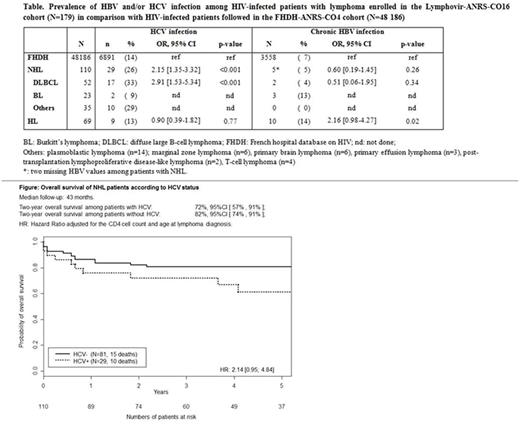Abstract
BACKGROUND: Human immunodeficiency virus (HIV) infection has been linked to an increased risk of non-Hodgkin's lymphoma (NHL) and Hodgkin's lymphoma (HL). In the HIV-uninfected population, hepatitis C virus (HCV) and hepatitis B virus (HBV) infections are both associated with an increased risk of NHL. Scarce data suggest an increased risk of HL in patients chronically infected with HBV. HCV and HBV coinfections are frequent among persons living with HIV (PLWHIV). The impact of HCV and HBV infections on HIV-associated lymphoma in the era of combined antiretroviral therapy (cART) deserves evaluation.
METHODS: We compared the prevalence of HBV and HCV coinfections between PLWHIV with lymphoma who were enrolled in the Lymphovir French National Agency for Research on AIDS and Viral Hepatitis (ANRS)-CO16 cohort and PLWHIV enrolled in the French Hospital Database on HIV (FHDH-ANRS-CO4) with at least one follow-up visit in 2011 (n = 48 186). This cohort has been shown to be representative of PLWHIV under care in France.
Lymphovir-ANRS-CO16 cohort enrolled consecutive HIV-infected individuals with lymphoma (NHL or HL) in 32 centers. The histological diagnosis was established using the 2008 WHO classification and was confirmed within the French hematopathology network (LYMPHOPATH). Finally, we analyzed the characteristics and outcomes of lymphomas in coinfected patients.
RESULTS: Between 2008 and 2015, 179 patients with HIV-related lymphomas were enrolled, of whom 110 had NHL (61%) and 69 had HL (39%), The HCV serology, available for all the patients, was positive in 38 cases (29 with NHL and 9 with HL). Among 26 HCV+ patients with available data, 15 had detectable HCV RNA load at lymphoma diagnosis, five had Child-Pugh A cirrhosis, two had liver fibrosis, and one had an extrahepatic manifestation (type III cryoglobulinemia). Overall, the HCV seroprevalence was 26% among patients with NHL, a proportion significantly higher than that in the FHDH-ANRS-CO4 cohort (14%) (odds ratio (OR): 2.15, 95% confidence interval [1.35-3.32])(Table). There was no association between HCV and HL (prevalence 13%, OR: 0.90 [0.39-1.82]).
The distribution of NHL subtypes among the 29 patients with HCV infection was as follows: DLBCL (n=17), MZL (n=3), plasmablastic lymphomas (n=3), primary effusion lymphoma (PEL) (n=3), BL (n=2), and T-cell lymphoma (n=1). HCV was significantly associated with DLBCL (prevalence 33%, OR: 2.91 [1.53-5.34]). Among the patients with DLBCL, 13/17 HCV+ patients had at least one site of extranodal involvement, compared to 16/34 HCV- patients (p=0.05). Four DLBCL patients received anti-HCV therapy after treatment of their lymphoma, consisting of IFN/ribavirin, either alone (n=1) or direct antiviral agents (n=3). A sustained virological reponse and a durable remission of their lymphoma were obtained in each case. Remarkably, a man with splenic MZL received anti-HCV therapy with interferon and ribavirin with no other lymphoma treatment, leading to long-lasting both virological and hematological complete responses. During follow-up, 10 deaths occurred among HCV+ patients with NHL due to progression of lymphoma (n=8) or solid tumours (n=2). With a median follow-up of 43 months, the 2-year OS among NHL patients tended to be lower in HCV+ patients (Figure).
HBV status was available for 177 of the 179 lymphoma patients, of whom 15 had chronic HBV infection based on HBs Ag positivity (n=13) or HBV DNA positivity (n=2). Five patients had NHL (DLBCL (n=2) and BL (n=3)) and 10 had HL. Overall, chronic HBV infection was present in 5% of patients with NHL, which did not differ from the value of the FHDH-ANRS-CO4 cohort (7%) (OR: 0.60 [0.19-1.45]). In contrast, the prevalence of chronic HBV infection was higher among patients with HL than in the FHDH-ANRS-CO4 (14%; OR: 2.16 [0.98-4.27]).
CONCLUSION: As compared with the general cohort of HIV-infected patients, HCV coinfection was associated with an increased risk of NHL, especially DLBCL, and tended to be associated with poorer outcome. While no increase in the risk of NHL was observed among HBV coinfected patients, chronic HBV infection was associated with an increased risk of HL. Our findings suggest that chronic antigenic stimulation induced by HCV or HBV contribute to lymphomagenesis in HIV-infected patients. It paves the way for evaluation of novel therapeutic strategies based on the newest direct antiviral agents for HCV coinfected patients.
Coiffier: Celltrion, Inc: Consultancy, Honoraria. Coppo: Alexion: Consultancy, Research Funding; Ablynx: Consultancy, Research Funding; Octapharma: Consultancy.
Author notes
Asterisk with author names denotes non-ASH members.


This feature is available to Subscribers Only
Sign In or Create an Account Close Modal